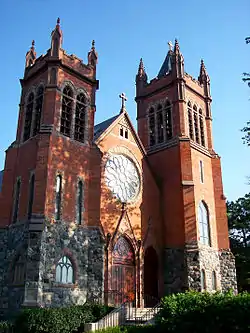Kirk in the Hills
Kirk in the Hills[1] Presbyterian (1958) is a church located in Bloomfield Township, Michigan.
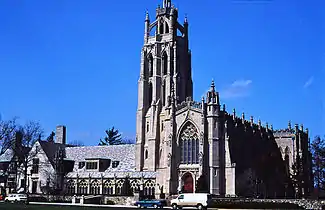
Overview
Kirk in the Hills is situated on a 40-acre setting on Island Lake. It is of Gothic design and is patterned after the famous Melrose Abbey in Scotland that was built in the 13th century.
The sanctuary is situated at the east end of Cedarholm, which was the home of Colonel Edwin S. George, whose gift of his home and estate in 1947 made the Kirk possible. As early as 1933 he saw the need for a church in this area and established the George Foundation for that purpose. The congregation was organized by the Presbytery of Detroit in 1947, and the first services were held that year in Cedarholm Chapel. The cornerstone for the church was laid in 1951, the same year Colonel George died. His remains are entombed under the Narthex of the Kirk's sanctuary.
The architectural firm of George D. Mason completed the church based on preliminary designs by Wirt Rowland.[2] Rowland, who worked for Mason at the beginning of his career, died in 1946 during the design process. Services were held in the Undercroft beginning in 1952 and continued during the construction of the church until a disastrous fire destroyed most of the roof. The Church held its first services in the sanctuary on November 23, 1958. Kirk in the Hills is modeled after Scotland's Melrose Abbey. Set on 40 acres (160,000 m2) of beautifully landscaped lakeside grounds, Kirk in the Hills constitutes a fine example of Gothic architecture in the United States. Kirk is the Scottish word for Church.
Tower and carillon
The church includes the Tower of the Apostles. The tower, which houses the world's largest carillon in the number of bells contained, was installed in 1960. The Bells were donated by the Roy A. Fruehauf family and the five largest bells are named after the members of the Fruehauf Family: Roy, Ruth, Royce, Randall, and Ruth Ann. Previously Mr. Fruehauf had donated the Organ to the Church after the fire. Mr. Fruehauf was instrumental in the building of the church and made a generous donation just before his death in 1965. The 77-bells range from a 6'10" 6-short ton bourdon to the smallest at 6" 14-pounds.
Sculpture
The church contains sculpture by some of the leading architectural sculptors of the day, Lee Lawrie, Corrado Parducci, and John Angel and Italian stone carver Harry Liva of Ingalls Stone Company in Bedford, IN, who worked in Indiana Oolitic limestone. The interior also contains ceramic tile by Pewabic Pottery. The gardens contain sculpture by Marshall Fredericks.
Sculpture gallery
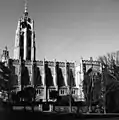
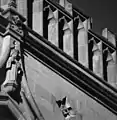
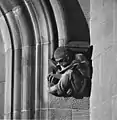 Architect Wirt C. Rowland
Architect Wirt C. Rowland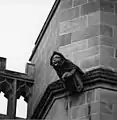
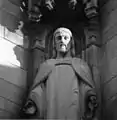
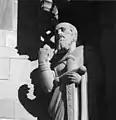
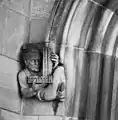 Edwin George with model of the Kirk
Edwin George with model of the Kirk
See also
- Architecture of metropolitan Detroit
- Melrose Abbey — Kirk in the Hills is patterned after Melrose Abbey in Scotland.
Notes
References
- Kvaran, Einar Einarsson, Architectural Sculpture of America, unpublished manuscript
- Meyer, Katherine Mattingly and Martin C.P. McElroy with Introduction by W. Hawkins Ferry, Hon A.I.A. (1980). Detroit Architecture A.I.A. Guide Revised Edition. Wayne State University Press. ISBN 0-8143-1651-4.CS1 maint: multiple names: authors list (link)
- Matuz, Roger (2001). Albert Kahn, Architect of Detroit. Wayne State University Press. ISBN 0-8143-2957-8.
Further reading
- Tutag, Nola Huse with Lucy Hamilton (1988). Discovering Stained Glass in Detroit. Wayne State University Press. ISBN 0-8143-1875-4.
